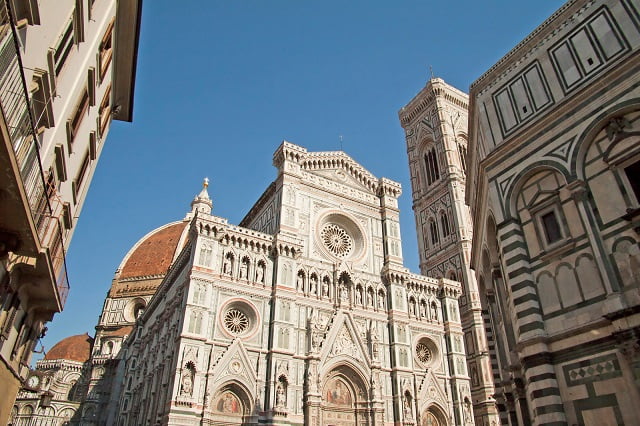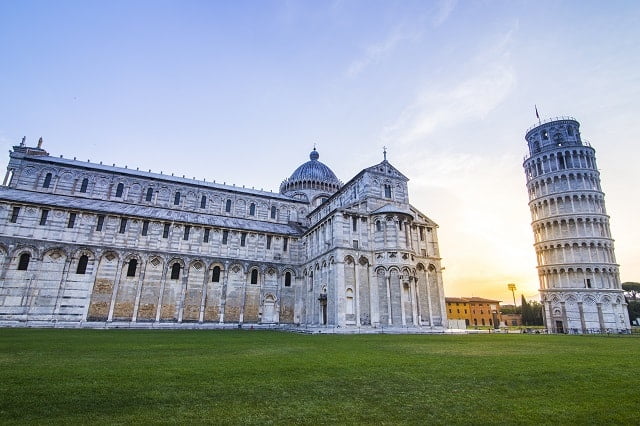
Italian arts and architecture have provided the world with some of its most remarkable sights. From some of the world’s most breathtakingly beautiful churches and cathedrals to captivating sculptures, a visit to Italy can be an experience that provides a unique treat to the eyes. Although it is difficult to know exactly when Italian art began, it is clear that since at least early Middle Ages Italians have been engaging in artistic endeavors of immense skill and beauty.
The Renaissance period of Italy was characterized by an unprecedented increase in creativity, featuring influential artists such as Michelangelo and Raphael. During this era, great advances were made in architecture, painting, sculpture, literature, music and philosophy. This was seen throughout the works of some of Italy’s greatest names in art history including Giotto, Filippo Brunelleschi and Leonardo da Vinci who created stunning works which still amaze people today. The Renaissance period certainly represents a highpoint for Italian art.
Italian Baroque architecture from the 17th century soon followed on from the Renaissance period creating masterpieces like St Peter’s Basilica in Rome as well as many other unforgettable landmarks such as St Paul’s Cathedral in London which play an important part in our culturalconsciousness today.
The 18th century Rococo movement led to lighter and more delicate pieces whereas the Neo-Classicalsculpture popular from mid-to-late 18th century tended to be concerned with grand classical forms with references to ancient Greek or Roman styles.
It can certainly be said that Italian arts and architecture have left an indelible mark on culture throughout Europe for centuries now having provided not only great sculptures but also some truly spectacular buildings which will continue to stand proudly for generations yet to come.
Ancient Etruscan Art
The Ancient Etruscan civilization was one of the most mysterious cultures of the ancient world. Influenced by other cultures and religions such as those of Mesopotamia, Greece, and Egypt, Etruscan arts were an amalgamated fusion of forms that developed during its growth in Italy. The first Etruscan art arose with pottery and ceramics decorated with geometric shapes, motifs in relief showing bulls, horses, and deities. These objects were used mainly for storage or sacred rituals.
While these stone monuments marked important burying places such as tombs of the elite aristocracy or necropolises, they also served as markers to mark where public buildings were built for political gatherings or trade centers. This type of monument-architecture often included raised religious-cult sites and early palaces indicating that a more sophisticated lifestyle was adopted by the culture.
In terms of sculpture, many have focused on works related to funerary art illustrating winged creatures that symbolized the journey into another life after death.
These raised reliefs often had lots of geometric ornamentation including spirals, acanthus leaves, animal figures created directly into walls or stone carvings depicting gods such as Apollo or Athena combined with various designs derived from Greek mythology like harpies and griffins. Scenes related to hunting and battle scenes related to war must also have been given a lot of attention due their prominence in Ancient Italian culture.
Other architectural feats enclosed rich painted shrines believed to hold sacred objects used for religious ceremonies such as bronze statuettes made after gods like Hercules or Mars seen throughout the Roman Forum today.
Generally speaking,ancient Etruscan Art was heavily partaken in sculptural works found in temples alongside buildings used for civil gatherings which helped create city-states while exploring realms unknown due to it being part of a much larger network connected throughout Europe’s medieval past during antiquity’s golden era until its decline when Rome seized control over two centuries later.
Ancient Roman Art
The world of art and architecture was revolutionized with the arrival of the Romans. Ancient Roman art and architecture flourished from the 8th century BC until the 5th Century AD. During this period, a variety of distinct styles emerged, some of which had a far-reaching influence on other cultures. Not only did they make advances in engineering and construction techniques but their sculptures, frescoes, mosaics and paintings influenced later movements around the world.
One of earliest periods in Roman art is known as Archaic Period (750 – 500 BC). In this early period, painting and sculpture were heavily influenced by Greek pottery designs or imported Greek motifs. Statues were more often idealized figures than realistic sculpture.
Generally there was little interest in naturalism. One of the most significant contributions of this era was their treatment of friezes which are extensive wall carvings found on many monuments such as temples or public buildings. It is believed that these ornate decorations were used to commemorate special events or important civic achievements.
The next major style period is referred to as Classical (500-100 BC). This style concentrated more on idealizing human forms depicting gods and goddesses with an increased attention to classical proportion, harmony and symmetry.
Famous examples include Augustus Prima Porta sculpture or Nike of Samothrace which both combine a sense of heroic poise perfect for representing power within a public setting; another example is The Boxer at Rest marble sculpture which conversely features a momentary gesture capturing human vulnerability through expressive postures instead.
Additionally, major advancement can be seen within architectural elements such as archways resulting in continuous load bearing structures that can support large load without additional buttressing supports being required for lateral or thrust stability.
In terms of murals/frescoes, Civil War scenes by history painter Fabius Pictor can be noted while Polygnotus oversaw some mural work in Delphi Theatre indicating the best artist available during ancient times put into practice artistic skills refined over centuries to leave lasting marks faced by millions today.
Popular among many mosaics remain those created notably by Giotto further propagating religious beliefs combined up with classic treatments like gold tesserae favoring them becoming iconic recognizable works recognized today beyond original regional artistic scope.
Overall an incredible number products exist all over italian lands testifying what stands thus far unparalleled accomplishment across European regions opened room for later art expressions throughout Renaissance era almost entirely derived from Italy’s precedent architectonic accomplishments enabling transfers developments across both fine arts genres for successive centuries
- Archaic Period – 750 to 500BC
- Classical – 500 to 100BC
- Fabius Pictor – civil war murals
- Polygnotus – Delphi Theatre murals
- Giotto – iconic mosaics
Renaissance Art
The Italian Renaissance from the fifteenth century up to the sixteenth century saw a dramatic shift in art, not only in Italy but throughout Europe as well. Breaking away from the medieval artistic traditions, Italian painters and sculptors began to explore more realistic depictions of human figures that attempted to recreate a lifelike model of beauty found in classical works.
This practice was also heavily used in sculpture by masters such as Michelangelo and Donatello who created works such as David (Michelangelo) and St George (Donatello). Both these examples show an incredibly detailed understanding of the human anatomy with taut muscles, intricate features, and heightened emotion creating an almost photo-like quality to their works.
Sandro Botticelli
One of the more famous painters who embraced this new way of painting was Sandro Botticelli. His works are some of the most iconic pieces of art from this period and include Stung Judith with Her Maidservant, The Birth Of Venus, Primavera, and The Mystic Nativity.
All these paintings possess his distinct style that shows off massive figures placed amongst carefully detailed backgrounds with a soft sense of color painting a dream like atmosphere. These qualities allowed him to create emotional stories through his art making them timeless pieces that have been appreciated for centuries.
Gian Lorenzo Bernini and Baroque Architecture
At the same time that Botticelli was painting his masterpieces Italy was also experiencing an evolution in architecture as well which is known today as Baroque architecture. This style can be attributed to one man, Gian Lorenzo Bernini who pushed past rigid classicism into a more vibrant interpretation where curves are dominant along with elegant sculptures often depicting religious story or mythological scenes such as his Ecstasy Of Saint Teresa (1647-52).
Bernini was also responsible for incredible churches across Rome such as Santa Maria Maggiore (1666-75) or San Giovanni in Laterano (1646-50). In both these structures architectural elements intermingle with his sculptures creating dynamic façades setting a precedent for future architects and designers alike.
Baroque Art
No country has embraced the richness of Baroque art quite like Italy. During the 17th and 18th centuries, Italian artists reinvented painting with dramatic stories infused with emotion and symbol loaded figures that bled off the canvas. Commissioned works by charitable donors often graced religious as well as public buildings, creating an environment of grandiose imagination and theatrical expression.
The movement began in Rome in 1625 when a group of baroque innovators formed the Accademia di San Luca that opened its doors to clergyman, sculptures, architects, poet and other creative activity. The most influential artistic minds studied conventional masterpieces while developing their own innovative styles intending to capture human emotion in every brushstroke.
Their work explored themes of individualism through powerful allegories such as history paintings like Caravaggio’s The Calling of Saint Matthew or illusionistic decorations characterized by Lanfranco’s Triumphal Entry into Rome featuring Apollo triumphant on a chariot drawn by four horses against a sky filled with billowing clouds.
Leading Baroque artists had powerful techniques for capturing realism:
- Fog wrapped landscapes bespeaking mystery – landscapes are submerged with mist rendering backgrounds unclear
- Bright light emanating from certain areas within the painting – draws viewers eyes to main subject pointedly
- Slowly receding backgrounds accentuating linear perspective – objects in space get smaller as they retreat
Baroque art style went beyond painting. Frescos, mural paneling, sculpture, furniture design, textile mosaics and architecture all became part of an innovative representation designed to tell stories which expressed daring creativity and romantic tales via exaggerated perspectives and emotionally charged imagery geared toward dominating one’s senses.
One example is Gian Lorenzo Bernini’s Ecstascis, a design for St Peters pendentive showing God revealing himself to Mary surrounded by swirling angels,billowing clouds and explosion of heavenly light – a voyeuristic fascination dynamic enough to draw people from far away even today.
Classic Italian Architecture
Italian art and architecture is renowned across the globe for its incredible beauty and enduring legacy. Ultimately, Italian architecture has provided much of the basis for classical design styles that are seen in not just Italy, but around the world. From traditional temples to modern cathedrals, Italians have been making their mark on the world for centuries.
The Renaissance period represents some of Italy’s most celebrated architecture. Coming out of a period in which the Ancient Roman architectural principles were prized above all else – with monumental structures such as St Peter’s Basilica garnering international acclaim. Classical architecture from this period particularly stands out for its immense scale; and for its balance between harmony, functionality and beauty, based on basic ratios that are meant to be aesthetically pleasing to both the eye and body.
Modern Italian Architecture
Fast-forward up to modern-day Italy, and many of the same design principles still apply within some parts of the country – although there’s now an increased focus on industrialisation and urbanisation too; as well as modern architectural interpretations of classic designs found throughout renaissance-era cities.
Buildings come in all shapes, sizes, colours and styles; making use of sculptural elements such as domes or triangular pediments to draw visual attention; while structural components help create differing shapes within windows or corridors which can emphasise light contrast or promote air flow within a property.
On top of this, more contemporary superstructures such as towers and skyscrapers have also been constructed in recent decades; drawing comparisons with other city skylines across Europe or elsewhere; while retaining enough unique features relative to more traditional Italian buildings so they don’t became homogenous ‘eyesores’. Towering steel frames often juxtapose against materials such as granite, marble or terracotta tilework to compliment local surroundings rather than contrast them.
Modern Italian Architecture
Since the end of World War II, architecture in Italy has gone through a period of major change and prolific development. In the mid-20th century, Italian architecture developed away from its Neo-classical roots and towards more modern style influenced by international trends. This trend found expression in works such as Gio Ponti’s Pirelli Tower and Mario Ridolfi’s Michelin Building both constructed in the 1950s.
The late 1960s saw the emergence of a new form of radicalism in Italian architecture as regional autonomy movements took hold throughout the country. These movements spread their influence to Italy’s urban centres, bringing about a wave of rationalist modern architecture that was uncharacteristically different from other European nations at the time.
Projects like Franco Albini’s San Michele Pronto Soccorso hospital ushering in what architectural historians have called ‘the Milanese school of modernity’ while projects such as Lodovico Barbiano di Belgioioso’s Fiera Milano fairground exemplified ‘the northern Italian radical movement’, developed by artists working outside instruction from larger organisations or institutions.
The 1970s saw some significant shifts within Italy’s creative world with designers turning away from past influences and focusing on innovative solutions to accommodate contemporary lifestyle habits and materials. Architects like Renzo Piano, Giuseppe Umbinoisra, Marco Zanusol created works that highlighted functionality while remaining visually stunning works; an example being Renzo Piano’s Centre Pompidou-Metz which is considered one of his best works displaying characteristic design elements that fuse innovation with attention to detail.
The late 1970s also welcomed postmodernist influence into Italian architecture – while some favourited this approach impassioned debates did emerge between architects who preferred maintaining traditional styles versus those who were more open to experimentation with new styles and forms.
By all counts it seems clear that since then Italian architects have been continually developing their perspective on modern architecture which is now highly varied, often considered even daring when compared to other European countries, giving new impetus for continued international excitement about Italian artistry in building design.
Examples of Notable Italian Art and Architecture
Bell Tower of St. Mark’s Basilica, Venice
The Bell Tower of St Mark’s Basilica in Venice stands at a majestic 98.6 meters and is an example of Italian artwork that has withstood the test of time. Built during the 12th century by Giacomo Barozzi and partially destroyed in an earthquake in 1902, the tower was rebuilt and reopened to the public in 1912 after a restoration.
The bell tower stands over Piazza San Marco and is considered one of Venice’s landmarks. The style is Venetian Gothic which blends elements from Byzantine and Islamic art as well as Moorish architecture.
Duomo di Milano Cathedral, Milan
Located in Milan is one of the most impressive architectural works of art ever constructed-the Duomo di Milano Cathedral. This colossal structure, also known as “The Last Judgement”, is said to be the largest church in all of Europe.
It was designed by Gian Galeazzo Visconti and takes architectural inspiration from both French Gothic and Italian styles throughout its decoration, towers, chapels, spires, pinnacles and stained-glass windows. From Gothic facades to Biblical scenes this cathedral truly embodies centuries’ worth Italian artwork within fact its walls.
David by Michelangelo
Considered to be one of Italy’s finest sculptures ever created for its subjective use of light and emotion is Michelangelo Buonarroti’s masterpiece David.
Made famous through its heroic representation epitomising strength; confidence; determination; intelligence; fearlessness whilst overcome with emotions – it is considered one his greatest works to date.Carved from a single piece marble obtained from Carrara – this 17ft masterpiece now stands preserved in Florence’s Accademia Gallery since 1873 where hundreds have travelled from different countries just to catch glimpse it every year.
Reflection
The Italian art and architecture of the Renaissance period has had a tremendous impact on today’s world. From the frescoes and sculptures of Michelangelo to the domed churches and grand palazzos of Brunelleschi, many of the most renowned works of beauty and splendor were created during this time in Italy. It can be seen as a symbol of Europe’s change from feudalism to more modern forms of government, science, and technology.
The movement also helped usher in changes that would have far-reaching effects on painting, sculpting, music composition, literature, engineering, mathematics and astronomy. This period is marked by increased innovation as well as a newfound ambition for exploration and discovery.
The impact that Italian art and architecture has had can be seen everywhere today. Think about any major city around the world such as Rome or Florence which are renowned for their magnificent architecture from this era. Today these cities remain incredibly popular tourist destinations due to their breathtaking array of sites depicting renaissance grandeur.
Not only is it architecturally significant but so too are its collections made up of iconic monuments including marble statues, mosaics, frescoes and paintings from this time. This kind of high art has grown in popularity over the ages; even today there are countless aspiring painters or sculptors who study masterpieces originating from pre-Renaissance Italy in an attempt to hone their craft just like those before them did centuries ago.
The influence of Italian arts can be seen outside of traditional forms such as painting or sculpture too; contemporary fashion magazines display clothes inspired by Renaissance brocades while home décor often pays homage with fresco designs or architectural detailing making it very easy to experience real renaissance flavor without traveling thousands miles away.
Moreover architects still pay tribute to Renaissance-era concepts when building corporate structures outfitted with domed skylines reminiscent of grand Italian churches such as Il Duomo di Firenze (Florence Cathedral).
These days it’s not at all uncommon for people who value tradition and culture to select an ornate villa for their summer holiday vacation rather than opting for one filled with mod cons when visiting Southern Italy’s countryside. The romantic lure that these places exude will always draw visitors back time after time.
It’s safe to say that much like wine, certain classic Italian arts will only improve with age since its enduringly beautiful works continue to capture our imaginations centuries later. Without doubt these are some good examples showing how our appreciation for artistic brilliance continues today through masterful design recreated year after year around the world.




